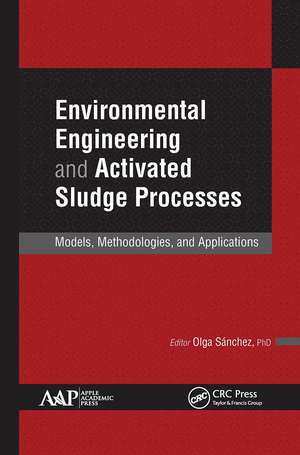Environmental Engineering and Activated Sludge Processes: Models, Methodologies, and Applications
Editat de Olga Sanchezen Limba Engleză Paperback – 31 mar 2021
The activated sludge process is one of the most versatile and commonly used wastewater treatment systems in the world. In the past, when industrial wastewater treatment focused on removing biological oxygen demand and suspended solids, waste water plants needed different processes and technology. The shift to the activated sludge process means environmental engineers must build new treatment plants and retrofit old ones. In this compendium, the editor, an experienced and well-published scientist in the field, has brought together articles that relate to the new requirements.
Preț: 579.62 lei
Preț vechi: 681.91 lei
-15% Nou
Puncte Express: 869
Preț estimativ în valută:
110.91€ • 116.11$ • 91.77£
110.91€ • 116.11$ • 91.77£
Carte tipărită la comandă
Livrare economică 07-21 aprilie
Preluare comenzi: 021 569.72.76
Specificații
ISBN-13: 9781774637081
ISBN-10: 1774637081
Pagini: 354
Ilustrații: 63
Dimensiuni: 152 x 229 x 19 mm
Greutate: 0.45 kg
Ediția:1
Editura: Apple Academic Press Inc.
Colecția Apple Academic Press
ISBN-10: 1774637081
Pagini: 354
Ilustrații: 63
Dimensiuni: 152 x 229 x 19 mm
Greutate: 0.45 kg
Ediția:1
Editura: Apple Academic Press Inc.
Colecția Apple Academic Press
Public țintă
Academic and PostgraduateCuprins
Models and Kinetics. Experimental and Theoretical Approaches for the Surface Interaction between Copper and Activated Sludge Microorganisms at Molecular Scale. A Novel Protocol for Model Calibration in Biological Wastewater Treatment. Sorption and Release of Organics by Primary, Anaerobic, and Aerobic Activated Sludge Mixed with Raw Municipal Wastewater. Removal Mechanisms and Kinetics of Trace Tetracycline by Two Types of Activated Sludge Treating Freshwater Sewage and Saline Sewage. Diversity of Activated Sludge and Process Microbiology. Evaluation of Simultaneous Nutrient and COD Removal with Polyhydroxybutyrate (PHB) Accumulation Using Mixed Microbial Consortia under Anoxic Condition and Their Bioinformatics Analysis. Characterization of Pure Cultures Isolated from Sulfamethoxazole-Acclimated Activated Sludge with Respect to Taxonomic Identification and Sulfamethoxazole Biodegradation Potential. Assessing Bacterial Diversity in a Seawater-Processing Wastewater Treatment Plant by 454-pyrosequencing of the 16S rRNA and amoA Genes. Nitrogen and Phosphorus Removal. An Efficient Process for Wastewater Treatment to Mitigate Free Nitrous Acid Generation and Its Inhibition on Biological Phosphorus Removal. Xenobiotics. Bacterial Consortium and Axenic Cultures Isolated from Activated Sewage Sludge for Biodegradation of Imidazoliumbased Ionic Liquid. Methane Production. Zero Valent Iron Significantly Enhances Methane Production from Waste Activated Sludge by Improving Biochemical Methane Potential Rather Than Hydrolysis Rate. Towards a Metagenomic Understanding on Enhanced Biomethane Production from Waste Activated Sludge after pH 10 Pretreatment. Biofilm Bioreactors. Isolation and Molecular Characterization of Biofouling Bacteria and Profiling of Quorum Sensing Signal Molecules from Membrane Bioreactor Activated Sludge. Scenario Analysis of Nutrient Removal from Municipal Wastewater by Microalgal Biofilms.
Descriere
This title includes a number of Open Access chapters.
The activated sludge process is one of the most versatile and commonly used wastewater treatment systems in the world. In the past, when industrial wastewater treatment focused on removing biological oxygen demand and suspended solids, waste water plants need
The activated sludge process is one of the most versatile and commonly used wastewater treatment systems in the world. In the past, when industrial wastewater treatment focused on removing biological oxygen demand and suspended solids, waste water plants need
